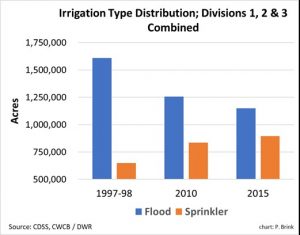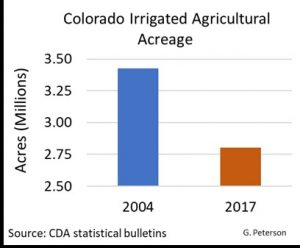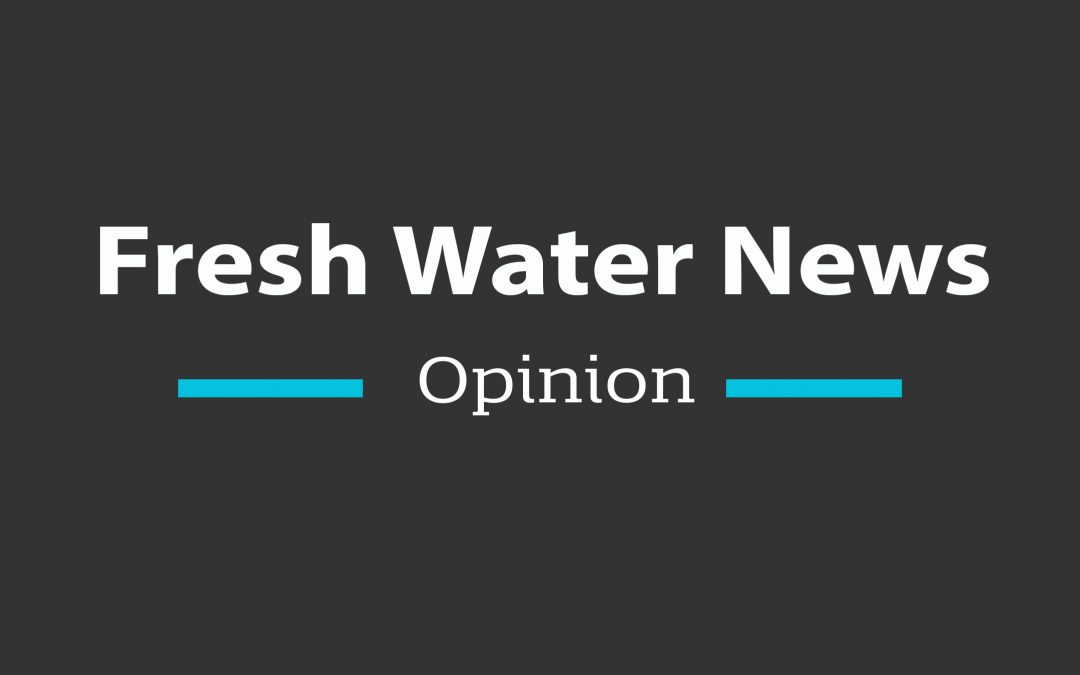This summer, like every summer, a cornucopia of Colorado grown foods will appear at grocery stores and farmers markets across the state. Coloradoans will once again be biting into juicy Palisade peaches and enjoying ripe Rocky Ford cantaloupe. What is the primary ingredient of these delicious products? Water. Cantaloupe and peaches are about 90 percent water. Those golden kernels of savory Olathe sweet corn? About 72 percent.
It takes a lot of water to grow food – but the amount that ends up in the food itself is a small part of the story. According to Colorado State University (CSU), more than 99 percent of the water used by irrigated crops or turf is drawn through the roots and transpired through the leaves. Only about a tenth of one percent (0.1%) of the water taken up by plants is actually used to produce plant tissue. In other words, crops use a lot of water to conduct photosynthesis and manage heat stress. The hotter it gets, the more water plants need.
Evapotranspiration (ET) is the term used to describe the water used by plants. Evapotranspiration is the water loss occurring from the processes of evaporation and transpiration. Evapotranspirative losses are determined by the combination of solar radiation, temperature, humidity and wind.
In Colorado, irrigation water rights are based on the historic ET of the crops grown plus any transit water that has historically been needed to deliver the water from the source to the field. The term “consumptive use” (CU) describes the measure of an irrigation water right, and includes these two elements. Crop water use, consumptive use and evapotranspiration (ET) are terms used interchangeably to describe the water consumed by a crop.
If farmers use more efficient irrigation methods, won’t they use less water?
Efficiency is often confused with conservation. Efficiency refers to the amount of water applied compared with the amount of water used by plants. If 100 acre-feet of water is applied to a field over a growing season and the crop consumptive use is 50 acre-feet, then the system is 50 percent efficient. The remaining half runs off the end of the rows and percolates down below the root zone. Surface and subsurface flows coming off flood and furrow irrigated fields may recharge groundwater, support stream baseflows, and/or be used by others downgradient – including other farmers, municipalities, industries, and domestic well owners. This practice enables multiple uses of water within basin systems and increases the water supply for aquatic life and downstream users in the latter part of the irrigation season.4 In many basin in the West, the total diversions vastly exceed the total flows in the river, which provides strong evidence for how important return flows are.
Irrigation efficiency is not included as a variable affecting plant ET. Greater irrigation efficiency does not mean lower total crop water use. In fact, improved irrigation efficiency may increase crop consumptive use. A more efficient irrigation method typically delivers water to crops in a more uniform and timely manner, creating conditions that optimize plant growth and yield, resulting in correspondingly higher ET losses. Other efficiency improvements like lining ditches and canals, may allow an irrigator to divert less water, but will negatively impact return flows. Those same lining projects may also harm beneficial or detrimental flora that grow along ditches and canals. Some of these plants we value for their aesthetics and habitat, while others can be an invasive nuisance. In most cases, irrigation efficiency doesn’t “save” water, it merely redistributes non-consumptive water away from return flows and phreatophytes, directly back to the river.
Another common misconception is that the amount of water applied to crops equals the amount of water used by the crops. An equally misunderstood variation on this theme is that the amount of water diverted equals the amount of water used by crops. In the absence of 100 percent irrigation efficiency, the amount diverted or applied is always more than the amount used by crops.
When it comes to agricultural water use and water rights, the historic consumptive use is the number that matters. Water diverted but not considered essential to accomplish delivery from the point of diversion to the field is not part of the water right associated with the field. Likewise, water applied on a field that is not used to meet plant ET requirements is not part of the water right. Only ET and essential transit water comprise an irrigation water right.
A February 19, 2020 article in Fresh Water News indicated that “Colorado’s ag water use has not changed, remaining almost exactly where it was 17 years ago, according to the USDA’s Irrigation and Water Management Survey.” Given the realities of plant ET rates, it is not surprising current crop consumptive use remains on par with historic consumptive use even though many acres have been equipped with more efficient irrigation systems (Figure 1).

Using less water on farms either means ‘buy and dry’ – which results in the permanent loss of irrigated farmland – or a temporary measure that reduces farm water consumptive use. The three water use reduction measures – or ‘alternative transfer mechanisms’ – being discussed in Colorado are rotational fallowing, crop switching and deficit irrigation.
Rotational fallowing means a field is fallowed all or part of a growing season. Crop switching refers to planting crops that use less water (ie. lower ET rates), such as substituting sorghum for corn. Deficit irrigation limits the amount of water applied on a field, which effectively reduces the consumptive use of a crop and reduces crop yield. The goal of all of the temporary water saving methods is to ‘free up’ water that would have otherwise been consumed by crops and then lease that water to others – such as cities – or fill reservoirs in anticipation of drier times. There are multiple challenges associated with any crop water use saving strategy, including quantifying the reduction in crop consumptive and determining how to prevent injury to other water right holders.
A substantial loss of irrigated farmland has occurred in Colorado (Figure 2), and more will occur. Greg Dewey of Northern Colorado Water Conservancy District reports that when the Colorado Big-Thompson (C-BT) project began, 97 percent of the water was allocated to farms. Today, only about 30 percent of C-BT shares remain under agricultural ownership. The balance – 70 percent – is owned by the Municipal and Industrial (M & I) sector.

The M & l sector leases some of the water they have purchased back to farmers until the water is needed to support M & I growth. Thus, even without additional water sales, more land in the South Platte River Basin will be dried up in the future.
Growing and consuming food locally creates a more efficient supply chain and connects growers with consumers. It is also crucial to maintaining Colorado’s food security. A Colorado Department of Agriculture survey found almost 85 percent of the Coloradoans agree that supporting local food systems is important, and 95 percent feel maintaining land and water in agricultural production is important.5 Preserving irrigated agricultural land is vital to preserving Colorado’s ability to feed itself, and to providing the open spaces, wildlife habitat, and beautiful rural vistas we cherish.
Phil Brink is a consulting coordinator of the Colorado Cattlemen’s Ag Water NetWORK.
Greg Peterson is executive director of CAWA.


 Print
Print